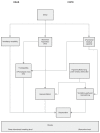Association of chronic obstructive pulmonary disease and obstructive sleep apnea consequences
- PMID: 19281082
- PMCID: PMC2650593
- DOI: 10.2147/copd.s4950
Association of chronic obstructive pulmonary disease and obstructive sleep apnea consequences
Abstract
Obstructive sleep apnea syndrome (OSAS) and chronic obstructive pulmonary disease (COPD) are two diseases that often coexist within an individual. This coexistence is known as overlap syndrome and is the result of chance rather than a pathophysiological link. Although there are claims of a very high incidence of OSAS in COPD patients, recent studies report that it is similar to the general population. Overlap patients present sleep-disordered breathing associated to upper and lower airway obstruction and a reduction in respiratory drive. These patients present unique characteristics, which set them apart from either COPD or OSAS patients. COPD and OSAS are independent risk factors for cardiovascular events and their coexistence in overlap syndrome probably increases this risk. The mechanisms underlying cardiovascular risk are still unclear, but may involve systemic inflammation, endothelial dysfunction, and tonic elevation of sympathetic neural activity. The treatment of choice for overlap syndrome in stable patients is CPAP with supplemental oxygen for correction of upper airway obstructive episodes and hypoxemia during sleep.
Figures


References
-
- Agusti AG, Noguera A, Sauleda J, et al. Systemic effects of chronic obstructive pulmonary disease. Eur Respir J. 2003;21:347–60. - PubMed
-
- Agusti AG. COPD, a multicomponent disease: implications for management. Respir Med. 2005;99:670–82. - PubMed
-
- Ambrosino N, Strambi S. New strategies to improve exercise tolerance in chronic obstructive pulmonary disease. Eur Respir J. 2004;24:313–22. - PubMed
-
- Andreas S, Anker SD, Scanlon PD, et al. Neurohumoral activation as a link to systemic manifestations of chronic lung disease. Chest. 2005;128:3618–24. - PubMed
-
- Andreassen H, Vestbo J. Chronic obstructive pulmonary disease as a systemic disease: an epidemiological perspective. Eur Respir J Suppl. 2003;46:2–4. - PubMed
Publication types
MeSH terms
LinkOut - more resources
Full Text Sources
Medical

